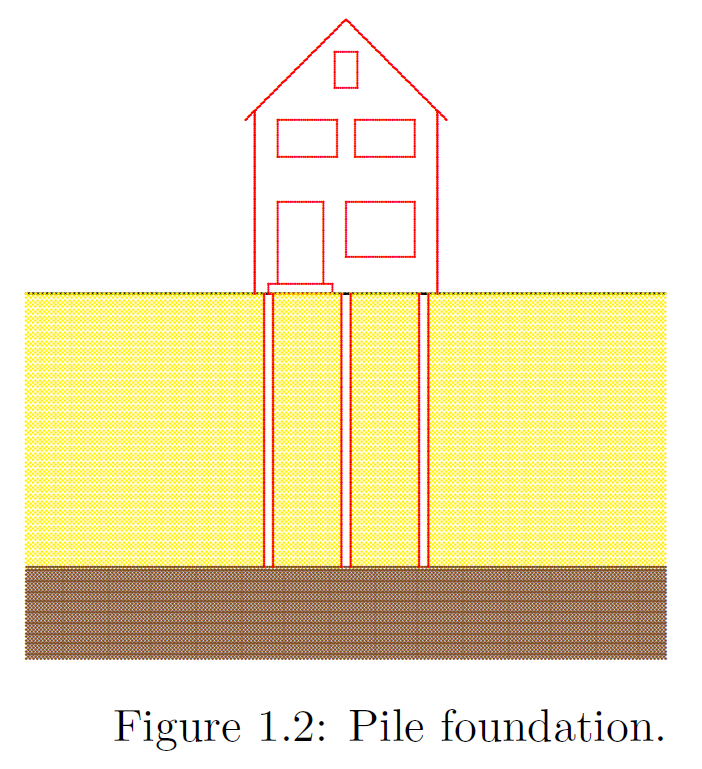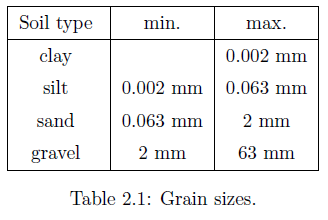The discipline Soil mechanics is the science of equilibrium and motion of soil bodies. Here soil is understood to be the weathered material in the upper layers of the earth’s crust. The non-weathered material in this crust is denoted as rock, and its mechanics is the discipline of rock mechanics. In general the difference between soil and rock is roughly that in soils it is possible to dig a trench with simple tools such as a spade or even by hand. In rock this is impossible, it must first be splintered with heavy equipment such as a chisel, a hammer or a mechanical drilling device. The natural weathering process of rock is that under the long-term influence of sun, rain and wind, it degenerates into stones. This process is stimulated by fracturing of rock bodies by freezing and thawing of the water in small crevices in the rock. The coarse stones that are created in mountainous areas are transported downstream by gravity, often together with water in rivers. By internal friction the stones are gradually reduced in size, so that the material becomes gradually finer: gravel, sand and eventually silt. In flowing rivers the material may be deposited, the coarsest material at high velocities, but the finer material only at very small velocities. This means that gravel will be found in the upper reaches of a river bed, and finer material such as sand and silt in the lower reaches. The Netherlands is located in the lower reaches of the rivers Rhine and Meuse. In general the soil consists of weathered material, mainly sand and clay. This material has been deposited in earlier times in the delta formed by the rivers. Much fine material has also been deposited by flooding of the land by the sea and the rivers. This process of sedimentation occurs in many areas in the world, such as the deltas of the Nile and the rivers in India and China. In the Netherlands it has come to an end by preventing the rivers and the sea from flooding by building dikes. The process of land forming has thus been stopped, but subsidence continues, by slow tectonic movements. In order to compensate for the subsidence of the land, and sea water level rise, the dikes must gradually be raised, so that they become heavier and cause more subsidence. This process must continue forever if the country is to be maintained. People use the land to live on, and build all sort of structures: houses, roads, bridges, etcetera. It is the task of the geotechnical engineer to predict the behavior of the soil as a result of these human activities. The problems that arise are, for instance, the settlement of a road or a railway under the influence of its own weight and the traffic load, the margin of safety of an earth retaining structure (a dike, a quay wall or a sheet pile wall), the earth pressure acting upon a tunnel or a sluice, or the allowable loads and the settlements of the foundation of a building. For all these problems soil mechanics should provide the basic knowledge.+
History
Soil mechanics has been developed in the beginning of the 20th century. The need for the analysis of the behavior of soils arose in many countries, often as a result of spectacular accidents, such as landslides and failures of foundations. In the Netherlands the slide of a railway embankment near Weesp, in 1918 (see Figure 1.1) gave rise to the first systematic investigation in the field of soil mechanics, by a special commission set up by the government. Many of the basic principles of soil mechanics were well known at that time, but their combination to an engineering discipline had not yet been completed. The first important contributions to soil mechanics are due to Coulomb, who published an important treatise on the failure of soils in 1776, and to Rankine, who published an article on the possible states of stress in soils in 1857. In 1856 Darcy published his famous work on the permeability of soils, for the water supply of the city of Dijon. The principles of the mechanics of continua, including statics and strength of materials, were also well known in the 19th century, due to the work of Newton, Cauchy, Navier and Boussinesq. The union of all these fundamentals to a coherent discipline had to wait until the 20th century. It may be mentioned that the committee to investigate the disaster near Weesp came to the conclusion that the water levels in the railway embankment had risen by sustained rainfall, and that the embankment’s strength was insufficient to withstand these high water pressures. Important pioneering contributions to the development of soil mechanics were made by Karl Terzaghi, who, among many other things, has described how to deal with the influence of the pressures of the pore water on the behavior of soils. This is an essential element of soil mechanics theory. Mistakes on this aspect often lead to large disasters, such as the slides near Weesp, Aberfan (Wales) and the Teton Valley Dam disaster. In the Netherlands much pioneering work was done by Keverling Buisman, especially on the deformation rates of clay. A stimulating factor has been the establishment of the Delft Soil Mechanics Laboratory in 1934, now known as Deltares. In many countries of the world there are similar institutes and consulting companies that specialize on soil mechanics. Usually they also deal with Foundation engineering, which is concerned with the application of soil mechanics principle to the design and the construction of foundations in engineering practice. Soil mechanics and Foundation engineering together are often denoted as Geotechnics. A well known consulting company in this field is Fugro, with its head office in Leidschendam, and branch offices all over the world.
The international organization in the field of geotechnics is the International Society for Soil Mechanics and Geotechnical Engineering, the ISSMGE, which organizes conferences and stimulates the further development of geotechnics by setting up international study groups and by standardization. In most countries the International Society has a national society. In the Netherlands this is the Department of Geotechnics of the Royal Netherlands Institution of Engineers (KIVI), with about 800 members.



